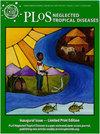麻风病的自愈:系统综述
IF 3.4
2区 医学
Q1 Medicine
引用次数: 0
摘要
背景麻风病由麻风分枝杆菌引起,影响身体多个系统,如不及时治疗,可导致可预防的残疾。虽然自 1982 年起就开始使用多药疗法 (MDT),但历史证据表明,未经治疗的麻风病可以自愈。然而,全球自愈率以及决定自愈的因素仍不清楚。方法 2023 年,我们利用 PubMed、Infolep 和 Web of Sciences 数据库中的数据以及谷歌搜索进行了一次系统性综述。数据提取和分析遵循 PRISMA 指南,并在单独的 Excel 表中进行了汇总。纳入的研究均为关于麻风病自愈的英文研究,不论发表年份。结果 我们纳入了六项研究,时间跨度从 1938 年到 1978 年,探讨了不同国家和大陆的麻风病自愈率。儿童、贫脓疱型 (PB) 病例以及可能是男性的麻风病人自愈率较高,平均自愈时间为两年。讨论/结论 最近关于麻风病自愈的研究很少,证据有限。这主要是由于对已确诊患者不予有效治疗的伦理考虑,以及缺乏对自愈的一致定义。不过,自愈似乎是一种可信的现象,受到地理、人口因素以及麻风病类型的影响。我们建议进一步研究麻风病的自愈现象,因为这有助于深入了解人体免疫系统及其决定因素。更深入的了解有助于调整临床实践和公共卫生策略,从而促进麻风病的有效管理和控制。本文章由计算机程序翻译,如有差异,请以英文原文为准。
Self-healing in leprosy: A systematic review
Background Leprosy, caused by Mycobacterium leprae , affects multiple body systems and can lead to preventable disability if untreated. While multidrug therapy (MDT) has been available since 1982, historical evidence suggests that untreated leprosy can resolve spontaneously. Nevertheless, the prevalence of self-healing worldwide, as well as factors determining self-healing, remain unclear. Methods A systematic review was conducted in 2023 with data from PubMed, Infolep, and Web of Sciences data bases, along with a google search. Data extraction and analysis followed PRISMA guidelines and were summarized in a separate Excel sheet. Included were English-language studies on self-healing in leprosy, regardless the year of publication. Results We included six studies spanning from 1938 to 1978 exploring the incidence of self-healing in different countries and continents. Children, paucibacillary (PB) cases, and possibly males showed a higher probability of self-healing with an average healing time of two years. Discussion/Conclusion Recent research on self-healing in leprosy is scarce and evidence limited. This is primarily due to ethical concerns regarding withholding effective treatment of diagnosed patients, and because of the absence of an agreed definition of self-healing. Nevertheless, self-healing appears to be a plausible phenomenon influenced by geographic and demographic factors, and the type of leprosy. We recommend further research on self-healing in leprosy, as it provides insight into the human immune system and the determinants of this phenomenon. More insight could help adapt clinical practices and public health strategies, thereby contributing to an effective management and control of this disease.
求助全文
通过发布文献求助,成功后即可免费获取论文全文。
去求助
来源期刊

PLoS Neglected Tropical Diseases
Medicine-Infectious Diseases
CiteScore
7.40
自引率
10.50%
发文量
723
审稿时长
2-3 weeks
期刊介绍:
PLOS Neglected Tropical Diseases publishes research devoted to the pathology, epidemiology, prevention, treatment and control of the neglected tropical diseases (NTDs), as well as relevant public policy.
The NTDs are defined as a group of poverty-promoting chronic infectious diseases, which primarily occur in rural areas and poor urban areas of low-income and middle-income countries. Their impact on child health and development, pregnancy, and worker productivity, as well as their stigmatizing features limit economic stability.
All aspects of these diseases are considered, including:
Pathogenesis
Clinical features
Pharmacology and treatment
Diagnosis
Epidemiology
Vector biology
Vaccinology and prevention
Demographic, ecological and social determinants
Public health and policy aspects (including cost-effectiveness analyses).
 求助内容:
求助内容: 应助结果提醒方式:
应助结果提醒方式:


